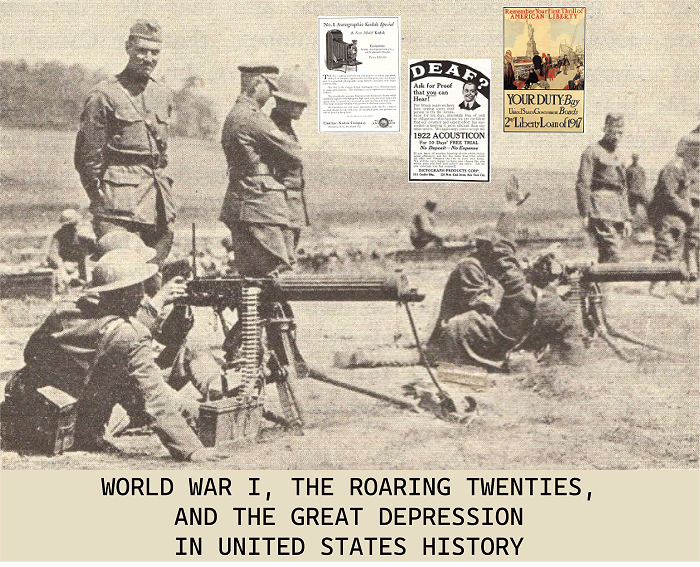The period of United States history that included World War I, the Roaring Twenties, and the Great Depression, was marked by significant social, economic, and political changes.
World War I (1914-1918): The United States entered World War I in 1917 after years of trying to remain neutral. The war had a profound impact on the nation, both economically and socially. It led to the mobilization of the U.S. economy, the expansion of the federal government's role, and the emergence of the United States as a global power. After the war, there was a brief period of optimism and idealism as President Woodrow Wilson advocated for the League of Nations and the principles of self-determination.
 The Roaring Twenties (1920s): The 1920s was a decade of cultural and social change characterized by economic prosperity and widespread consumerism. It saw the rise of the automobile industry, the expansion of mass media and entertainment, and the growth of a consumer-driven economy. The era was marked by Prohibition, which banned the sale of alcoholic beverages but also gave rise to illegal speakeasies and organized crime. The 1920s also witnessed the emergence of a vibrant youth culture, the Harlem Renaissance in African American arts and culture, and significant changes in women's roles and fashion, including the flapper style.
The Roaring Twenties (1920s): The 1920s was a decade of cultural and social change characterized by economic prosperity and widespread consumerism. It saw the rise of the automobile industry, the expansion of mass media and entertainment, and the growth of a consumer-driven economy. The era was marked by Prohibition, which banned the sale of alcoholic beverages but also gave rise to illegal speakeasies and organized crime. The 1920s also witnessed the emergence of a vibrant youth culture, the Harlem Renaissance in African American arts and culture, and significant changes in women's roles and fashion, including the flapper style.
The Great Depression (1929-1941): The stock market crash of 1929 marked the beginning of the Great Depression, a severe and prolonged economic downturn. It resulted in widespread unemployment, bank failures, and widespread suffering across the nation. President Herbert Hoover struggled to address the crisis effectively, and public discontent grew. The election of Franklin D. Roosevelt in 1932 ushered in the New Deal, a series of government programs and reforms aimed at providing relief, recovery, and reform. The New Deal included initiatives such as Social Security, the Civilian Conservation Corps (CCC), and the Works Progress Administration (WPA) to combat unemployment and stimulate the economy. While the New Deal programs had varying degrees of success, they reshaped the role of the federal government in American society.
This period of U.S. history encompassed the transition from World War I to the Roaring Twenties, characterized by social and cultural change and economic prosperity, and then to the Great Depression, a time of economic hardship that led to significant government intervention and reform efforts. These events had a profound and lasting impact on the nation, shaping the course of American history for decades to come.
|
 The Roaring Twenties (1920s): The 1920s was a decade of cultural and social change characterized by economic prosperity and widespread consumerism. It saw the rise of the automobile industry, the expansion of mass media and entertainment, and the growth of a consumer-driven economy. The era was marked by Prohibition, which banned the sale of alcoholic beverages but also gave rise to illegal speakeasies and organized crime. The 1920s also witnessed the emergence of a vibrant youth culture, the Harlem Renaissance in African American arts and culture, and significant changes in women's roles and fashion, including the flapper style.
The Roaring Twenties (1920s): The 1920s was a decade of cultural and social change characterized by economic prosperity and widespread consumerism. It saw the rise of the automobile industry, the expansion of mass media and entertainment, and the growth of a consumer-driven economy. The era was marked by Prohibition, which banned the sale of alcoholic beverages but also gave rise to illegal speakeasies and organized crime. The 1920s also witnessed the emergence of a vibrant youth culture, the Harlem Renaissance in African American arts and culture, and significant changes in women's roles and fashion, including the flapper style. 






